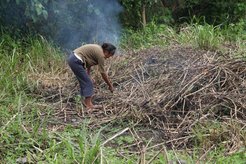Beyond ‘Wilderness’ - Biodiversity Conservation Approaches Need Indigenous and Local Peoples
A new perspective article published in a special edition of PNAS titled ‘Tropical Forests as Key Sites of the Anthropocene’ pairs Indigenous scholarship with palaeoecological, archaeological, geographical, and anthropological research from the global tropics to explore some of the key barriers posed by pervasive “wilderness thinking” for the conservation of some of the most biodiverse places on earth.
Tune into any nature documentary or visit the natural sciences section of your local bookshop and you will be instantly confronted with the catastrophic impacts of people on the natural world. David Attenborough’s compelling, and at times incredibly distressing, Witness Statement for the Planet, released on Netflix in 2020, illustrates just this by documenting the loss of wild places on earth: over 1/5 of the globe’s surface in just 60 years. His primary solution? Protect remaining wildness. And while the need to conserve biodiversity for the health of the planet is indisputable, deep-time scientists and Indigenous and local communities living in and investigating these supposedly “wild” places are concerned over the research, policy and educational implications of viewing environmental sustainability through the lens of “wilderness.”
A new perspective article published in a special edition of PNAS titled ‘Tropical Forests as Key Sites of the Anthropocene’ pairs Indigenous scholarship with palaeoecological, archaeological, geographical, and anthropological research from the global tropics to explore some of the key barriers posed by pervasive “wilderness thinking” for the conservation of some of the most biodiverse places on earth.
The article – a collaboration between physical and social scientists from the University of Melbourne, Australia and The Max Plank Institute for the Science of Human History in Jena, Germany – draws on more than 50 case studies from the tropics that collectively demonstrate how biodiverse landscapes have been shaped and managed by people over millennia. Yet despite this compelling body of evidence, “pristine wilderness” is a still a common conservation goal pursued in the tropics.

Dr. Rebecca Hamilton, a conservation palaoeoecologist based at the Max Planck Institute for the Science of Human History in Jena and coauthor of the study, describes some of the problems with using “pristine nature” as a benchmark in conservation planning.
“Our research demonstrates that attempting to distinguish the ‘wild’ from the ‘tame’ and the ‘non-human’ from ‘human’ ignores the long and enduring legacies of Indigenous and local people in shaping, making and protecting landscapes world over,” Hamilton says. “Problematically, this ignorance has the potential to eliminate people and the deep knowledge systems that have encouraged long-term biodiversity functioning and resilience from the very places that we are seeking to protect.”
For Associate Professor Michael Shawn Fletcher, Wiradjuri (Australian Indigenous) scientist from the University of Melbourne and lead author of the article, the message is clear:
“The catastrophic wildfires and environmental degradation now occurring in (among other places) Australia, northwest America and the Amazon – all lands invaded and colonised by Europeans – are at least partly the result of removing Indigenous and local people whose knowledge and actions gave us the very landscapes we strive to conserve. Science alone has failed to solve these problems. Exported land management approaches from Europe across the Earth have failed.”
The solution?
“We need to abandon the wilderness trope and the myth that science is an objective pursuit. We need to engage and embed other ways of viewing the world if we are to survive on this planet,” says Fletcher. “Indigenous and local peoples must be engaged in the full range of efforts that impact their lands, from inception and implementation of environmental initiatives, policy making, production and execution of research questions and agenda, environmental management and monitoring.”
